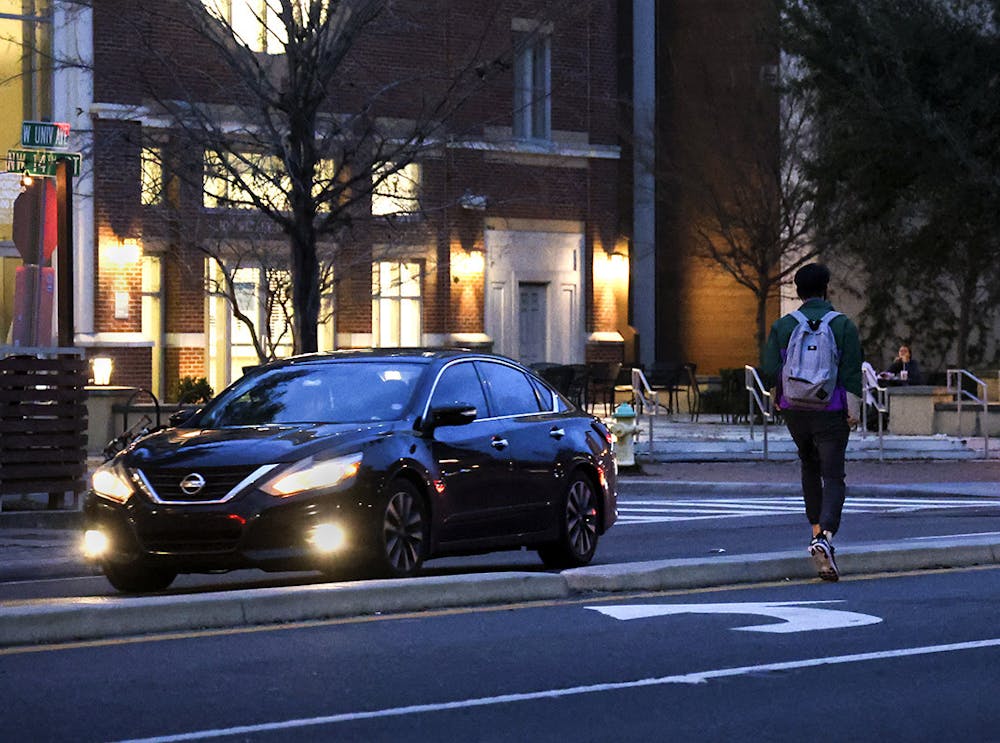An Alachua County ordinance that prohibits pedestrians from standing in road medians less than 6 feet wide passed Tuesday mirrors a law passed by Gainesville City Commission a month ago.
At the beginning of February, the Gainesville City Commission unanimously approved a similar pedestrian safety ordinance that also banned pedestrians from standing in medians 6 feet wide or less. The ordinance went into effect Feb. 8.
The new rule came after the city experienced more than 80 traffic crashes and multiple deaths, including students,over the past few years. A crash in April 2019 killed David Washington, a homeless man standing at the intersection of Northwest 43rd Street and 16th Boulevard. Following the crash, City Commissioner Harvey Ward proposed the new median ban that would fine those who stand in road medians.
Similarly, Alachua County passed its ordinance to keep panhandlers out of road medians.
Until recently, Gainesville allowed individuals to panhandle in road medians seeking small cash from idling drivers waiting for a green light.
Though the city and county’s laws come without an alternative for the homeless population standing on medians for money, it does invite police officers to show some leniency.
Following a recommendation from the city, GPD announced in February it would issue warnings for pedestrians in violation instead of fines. The new ban states that officers should issue one-year warnings, which will serve as a log for other officers to determine if someone has already violated the same law.
Police are to issue fines for repeat violators starting at $50, according to the ordinance. After a third offense, the penalty will total $100, and any offenses after that will result in civil court.
However, more than a month after the city ordinance went into effect, GPD has not yet filed an official warning or cited any individuals for violating the law, according to GPD spokesperson Graham Glover.
Glover said there isn’t a time set in stone when GPD would start issuing formal warnings and fines. The city’s current priority is to educate individuals before starting enforcement, Glover said.
“There is no specific date,” he said, “But probably in the next week or so.”
The city and county bans raise concerns among community members about the impact on people who rely on asking for money in medians for income.
The Continuum of Care program is a North Central Florida Alliance for the Homeless and Hungry program that coordinates housing and services for people experiencing homelessness. Patrick Doods, the director of the CoC, said as an advocate for homeless people, he is concerned the ordinance will impact panhandling individuals financially.
Interactions with law enforcement could be traumatic for homeless people, Dodds said. Many individuals who are panhandling rely on the change they collect for income, and without the money they experience more stress and pressure. Working with the city, Dodds said he hopes to establish a more thorough safety net for the homeless.
“We want to avoid any law enforcement interactions that can ultimately cause harm to these individuals,” he said.
Though he believes there are legitimate reasons for the median ban, Dodds worries it is merely an addition to a long list of obstacles homeless people have to overcome.
Many people misunderstand how much money panhandling generates, he said. The amount collected from a full day of panhandling hardly covers the cost of a meal and something to drink.
Rather than only increase the safety of pedestrians as intended, the ordinance also may just encourage people to move around, he said.
“We may end up seeing a game of musical chairs where people simply move to other locations,” he said.
Dodds worries construction zones or unsafe corners may become new bases for homeless people to ask for money as they are pushed out of medians with no alternative.
However, City Commissioner David Arreola said he supports the ban, but nviews it as an imperfect solution to an imperfect problem. He felt medians are too dangerous a place for anyone to be standing.
“All it takes is for one driver to not be looking where they're going, and it could be a tragedy,” Arreola said.
Arreola said the answer to supporting the city’s homeless population lies not in rejecting the median ban. Instead, it’s greater engagement with the homeless population to help them achieve employment, housing and other social services.
But city residents have mixed feelings on the rule.
Faisal Herzallah, a 21-year-old UF physics junior, said he is optimistic the rule could save the lives of pedestrians crossing the street but worries it will hurt homeless people's ability to make a living.
“Gainesville's homeless population were already suffering before the rule went into effect,” Herzallah said. “Surely the city could have considered our homeless population by only banning it on roads where accidents happen frequently or by coming up with an alternative.”
Rasmus Brinch Nielsen, a private-sector executive of JobTeam A/S, a national company with 30 subsidiaries, who deals with city planning and construction, is also ambivalent toward the city’s rule.
While he said it may reduce accidents involving pedestrians, it could have a negative social impact on the city’s homeless population.
“Narrow medians are dangerous for pedestrians in any city. Factoring in the heavy traffic flows that Gainesville sees, I think the ban will save lives in the future,” Brinch Nielsen said. “However, I am concerned that the city has provided no viable alternatives for panhandlers or students crossing the street.”
Brinch Nielsen said he believes the city could construct more pedestrian overpasses on roads like University Avenue and 13th Street to support the new ordinance.
"The City cannot expect to solve any problems merely by imposing a ban," he said. "If banning things actually solved problems, no one under 21 would be drinking on Saturdays in Gainesville."
Contact Emil Munksgaard Grosen at emgrosen@alligator.org. Follow him on Twitter @EmilMunkGrosen.

Emil Munksgaard Grosen is a news assistant for The Alligator and a sophomore who plans to double major in political science and public relations. Interested in civil rights and political communication, he dreams of becoming a lawyer and humanitarian.






